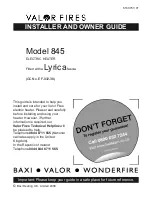
CAMPO EQUIPMENT CO. LTD. (ECOBLAZE)
6 Carson Court, Brampton, ON, CANADA, L6T 4P8
Tel: (905) 793-2525 | Fax: (905) 793-8768 |
www.campoequipment.com
P a g e
|
19
COMBUSTION AIR ADJUSTMENTS
For proper combustion air adjustment a calibrated
gas analyzer and smoke tester should be used to
ensure complete combustion. Air adjustment should
be made at the correct input and be adjusted to
achieve 5% Oxygen and 12% CO2. For optimum
combustion efficiency the combustion air control
should be set to provide no more than No. 1 smoke
(Bacharach Scale). The Beckett burner has a
calibrated air band, which will assist in adjusting the
primary air for a good oil/air mixture. Adjust the air
band supply by loosening lock screws and moving air
shutter and if necessary the bulk air band. Begin by
reducing the air until the unit begins to produce
smoke. Increase air until no smoke is produced.
Check for excessive heat build up in the heat
exchanger. Insufficient air will cause flame
impingement and reduced heat exchanger life.
Increase air until heat build up has been eliminated.
Check for proper ignition. Once satisfied re-tighten all
screws and locking mechanisms.
This adjustment is to be carried out while the unit is operating and after 5 minutes of firing. Rotating the air bands on
the burner housing makes the adjustment.
SETTING GAS FIRING RATES
1.) Choose BTU required and fuel supplied. For example 175,000 BTU and Natural Gas with the Beckett CG4.
2.) Adjust the manifold pressure to the recommended setting (3.5).
3.) Check nameplate for recommended air setting. A 9/2 air setting is recommended.
4.) Measure the carbon monoxide level and adjust air settings, if necessary, to regulate it to about 50 PPM for a
starting point.
5.) Measure the O2 or CO2 at the 50 PPM level. For example, assume the O2 is 1.5% (11% CO2).





































